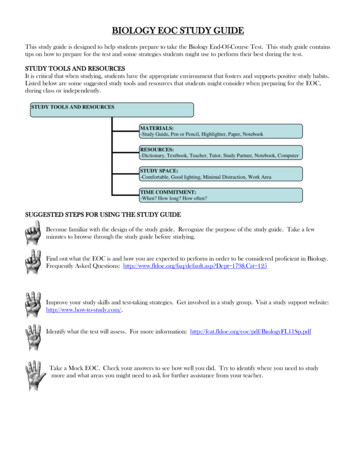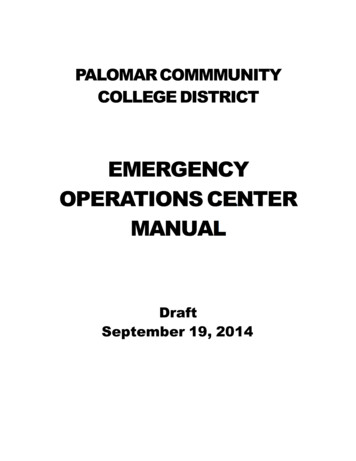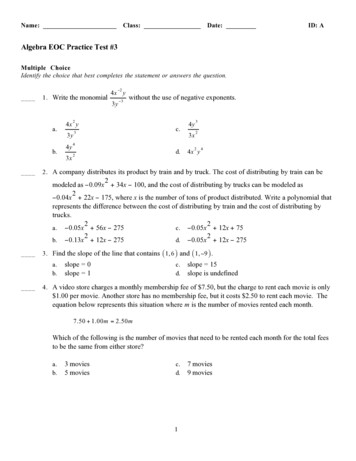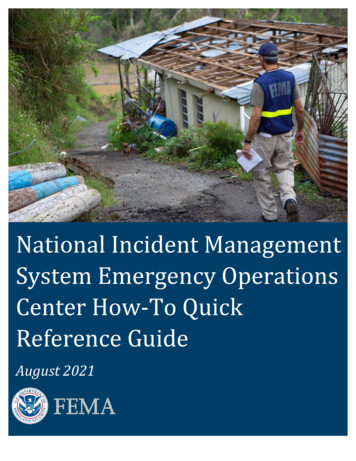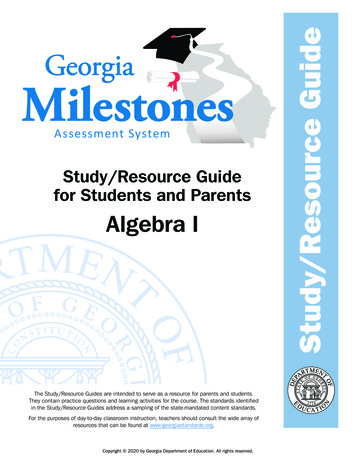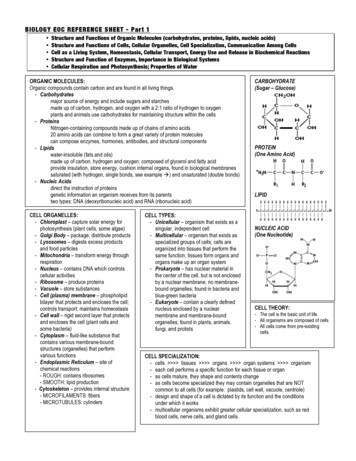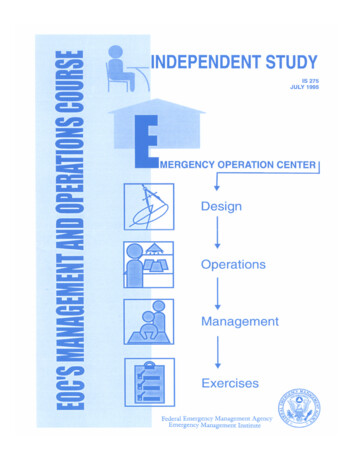
Transcription
ecoveryActivitiesTABLE OF CONTENTSForeword . iiIntroduction. iiiModule 1: The Role of the Emergency Operations Center. 1-1Module 2: EOC Management and Operations: Roles and Responsibilities . 2-1Module 3: Developing EOC Policies and Procedures . 3-1Glossary . G-1Resources . R-1References. RF-1Curriculum Guide . CG-1Appendix A: Sample Hazard Vulnerability Analysis. Appendix–AAnswer Key . Answer Key–1Final Examination. Final Exam–1IS-i
Foreword
ecoveryActivitiesForewordCourse SponsorsThe Emergency Management Institute (EMI) had the primary rolefor coordinating development of this course.Independent Study CourseThis independent study course is geared toward persons who haveresponsibility for management and operations of the EmergencyOperations Center (EOC). It is a prerequisite for enrollment in theEOC Management and Operations course which is described in theintroduction. The course includes a final examination, which must becompleted with a passing rate of 75% or higher to enroll in the EOCManagement and Operations course.ForewordIS-ii
Introduction
ction reports and studies of catastrophic disasters haveidentified the need for training in response and recovery operations,including Emergency Operations Center (EOC) management.Additionally, interviews conducted by EMI officials with State andlocal emergency management directors, operations officers, andtraining officers indicated a need for training in EOC management.Based on the findings of a front-end analysis and design meeting, acurriculum was developed to provide those persons withresponsibility for EOC management and operations with theknowledge and skills they need to perform their jobs.Curriculum GoalThe goal of the EOC Management and Operations curriculum is toprovide State and local emergency management officials with theknowledge and skills they need to operate the EOC. The curriculumis designed using a performance-based approach that emphasizeslearning activities that are easily transferable to the job.Curriculum OverviewThe curriculum consists of the independent study course and theEOC Management and Operations course. The diagram on thefollowing page provides an overview of the course content. Theindependent study course is a prerequisite to enrollment in the EOCManagement and Operations course.IntroductionIS-iii
ecoveryActivitiesIntroductionIS-iv
ecoveryActivitiesCourse OverviewThis independent study course is intended to provide you with ageneral introduction to the role of the Emergency Operations s,therolesandresponsibilities of the person(s) responsible for EOC management andoperations. It also provides an overview of the types of standardoperating procedures required for effective EOC operations.It is expected that participants will have some general knowledge ofemergency management. However, experience in managing an EOCis not a requirement for this course.This course contains three modules, a glossary, a resource section, acurriculum guide to help you continue learning, and a finalexamination.Module 1: The Role of the Emergency Operations Centerdescribes the functions of the EOC, identifies considerationsregarding EOC staffing, identifies minimum EOC resourcerequirements, and describes the physical characteristics of an EOC.Module 2: EOC Management and Operations: Roles andResponsibilities describes the roles and responsibilities of theperson(s) responsible for EOC management and operations.Module 3: Developing EOC Policies and Procedures providesessential information on the requirements of policies and standardoperating procedures for communications systems, life supportsystems, operating equipment and supplies, memorandums ofunderstanding, and records and documentation retention for EOCoperations.The glossary, located at the end of the final module, containsdefinitions of terms related to EOC management and operations. Theglossary may be consulted while you are reading the modules, or maybe read separately.A resource section is included to help you continue learning afteryou have completed the course. It consists of a list of references andother recommended courses.A curriculum guide is included to help you locate other courses thatmay be helpful in learning about specific aspects of the dwarningsystems.IntroductionIS-v
ecoveryActivitiesThe final examination, located at the end of the course materials, willtest the knowledge you have gained from the course. An answer sheetis supplied with the course materials. Mail the completed form to theaddress on the form, or if you have been given other instructions,follow those. You must score 75% or higher to enroll in the EOCManagement and Operations course.How to Complete This CourseYou can gain more from your independent study learning experienceby following these study tips.You will remember the material best if you do not rush through it.The more you interact with the material, the better you willremember it! Take a break at the end of each module, and giveyourself time to think about the material.For the video segment of this course, first view the video in itsentirety. Then, complete the questions that pertain to the video. If n.IntroductionIS-vi
Module 1THE ROLE OFTHE EMERGENCYOPERATIONS CENTER
ecoveryActivitiesModule 1THE ROLE OFTHE EMERGENCY OPERATIONSCENTEROBJECTIVESAt the end of this module, you will be able to do the following:1. Describe the functions of the EOC.2. Identify considerations regarding EOC staffing.3. Identify minimum EOC resource requirements.4. Describe the physical characteristics of an EOC.CONTENTREQUIREDMATERIALSTitleIntroductionFour Phases of Emergency ManagementThe Role of Emergency Operations Center—Video TapeLearning ActivitySummaryPage1-21-21-41-81-14Course manualVideo Cassette Recorder (VCR)Videotape: The Role of the Emergency Operations CenterThe Role of the Emergency Operations CenterIS-1-1
ecoveryActivitiesIntroductionEmergency management is the process of coordinating availableresources to deal with emergencies effectively, thereby saving lives,avoiding injury, and minimizing economic loss.Major emergencies or disasters can cover several jurisdictions andmay require large-scale government and voluntary agency response.When an emergency threatens, hundreds to thousands of people mayneed to be warned and protected. Emergency services must be readyto care for the injured and to give shelter to those who cannot remainin their homes. Communications systems must be in place, andsomeone must direct the response activities. There must be ways toassess the damage caused by the emergency, to return people safely totheir homes after the danger has passed, and to help people andbusinesses return to normal as soon as possible. Efforts must be madeto increase safety in the face of future emergencies.This protection process involves four phases of emergencymanagement: mitigation, preparedness, response, and recovery.Four Phases ofEmergencyManagementMitigation. This phase includes any activities that prevent anemergency, reduce the chance of an emergency occurring, or reducethe damaging effects of unavoidable hazards. Mitigation activitiesshould be considered long before an emergency occurs.Preparedness. This phase includes developing plans to ensure themost effective, efficient response; taking steps to minimize damages,such as installing forecasting and warning systems; and equipping theEOC for operations during an emergency. A key component of thepreparedness stage consists of training and exercising the EOC andthe personnel and volunteers who will be staffing the EOC in anemergency.Response. Response is the first phase that occurs after the onset of anemergency or disaster. It is intended to provide emergency assistancefor casualties, including search and rescue, shelter, and medical care,to reduce the probability of secondary damage and to reduce damageby efforts such as sandbagging against impending floodwaters.The Role of the Emergency Operations CenterIS-1-2
ecoveryActivitiesRecovery. The activities undertaken during this phase involve steps toreturn all systems to normal after an emergency. This phase includessuch functions as redevelopment loans, legal assistance, andcommunity planning.Experience shows that these phases are cyclical, as illustrated below,rather than linear in their interrelationships. All activities andexperiences lead individually and cumulatively back to the ONSEFour Phases of Emergency ManagementPut another way, we learn to prevent and diminish future emergenciesby what we learn from past events, whether through actualemergencies or through simulation of response activities. The disasteror emergency, actual or potential, can be seen as the motivating forcefor the motion of the cycle.Every community, no matter how large or small, urban or rural, will beable to improve its ability to centralize and coordinate the flow ofinformation during an emergency (and the effectiveness of responseand recovery operations) by establishing an EOC.The videotape that you will watch next provides a good introduction toemergency operations management. The following is a briefintroduction to the video, “TheRoleoftheEmergencyOperationsCenter.”After you have read the introduction, you can begin viewingthe video.The Role of the Emergency Operations CenterIS-1-3
yOperationsCenter”VideotapeThe videotape begins with a montage of disaster scenes, includingfloods, hurricanes, an airplane crash, tornadoes and earthquakes. Onscene modules responding to disasters are also depicted. A narratorexplains that emergencies can occur anywhere, at any time, and thatsuchemergenciescanoverwhelm acommunity’sabilitytorespondbyordinary methods. Extraordinary methods are required to meet largescale emergencies, and Emergency Coordination Centers (ECCs)provide direction for such disaster response ofNorthCarolina’sDivision of Emergency Management. The Director describes neHugo.Inasecond interview, the Director of Disaster and Emergency EOC’sresponsetothe plane crash in 1989.After the interviews, scenes inside an EOC provide the setting fordiscussing the location and layout of ECCs. Also identified are theequipment, facilities, and resources required to support an EOC in amajor emergency.The videotape highlights the duties of, and the interaction among, EOCpersonnel during a full-scale exercise.A former Emergency Operations Manager then discusses theimportance of exercising the staff of an EOC on a regular basis.The Role of the Emergency Operations CenterThe video lasts 18 minutes and 6 seconds. After viewing the video, beprepared to answer questions about what you learned. Use the spaceprovided on the following page to take notes.The Role of the Emergency Operations CenterIS-1-4
ecoveryActivitiesNOTESWhen you finish viewing this video segment, stop the tape and returnto the text.The Role of the Emergency Operations CenterIS-1-5
ecoveryActivitiesThe following are key points that you should remember about the role ofthe Emergency Operations Center.Key Points1. e,andrecovery. They are crucial to saving lives and property.2. ECCs pull together people and resources to handle emergencies anddisasters that are outside the ability of single departments to handle.3. tsthroughthe centralized, coordinated efforts of government officials, responseagencies, and community volunteers.4. ECCs provide a means of centralizing and managing communicationsand information within an EOC, between an EOC and the IncidentCommander in the field, and between the EOC and the public.5. There is no one type of EOC; they vary in size and configuration, andmost facilities will serve dual purposes.6. Location of the EOC must be based on an analysis of potential threatsto the community, since it must survive likely disasters.7. Alternate sites, backup power, and communications equipment willensure continued operations in even the worst conditions.8. ECCs should protect communications and Automated Data Processing(ADP) equipment from power surges and other electromagnetic effects.9. ECCs must have the resources and trained personnel to handle longterm operational requirements such as sustained occupancy.10. EOC staff job assignments must be carefully planned, exercises mustbe conducted, and regular training must be provided.11. The Standard Operating Procedures (SOPs) (tailored to individualECCs) are the key document for planning, training, and operationalguidance.The Role of the Emergency Operations CenterIS-1-6
ecoveryActivities12. Documentation management must safeguard documents generated orreceived by ECCs for use after an emergency.Learning ActivityTake a few minutes to complete the learning activity on the following page.The Role of the Emergency Operations CenterIS-1-7
ecoveryActivitiesLearning ActivityPurpose:To assess your understanding of the information that was presented in the video.Directions:Answer the following questions. You can check your answers in the Answer Keysection.1.What roles does an EOC perform that can save lives and property?2.During a disaster, response operations must be run efficiently and in a coordinated manner.How does an EOC help achieve such a response?3.If individual departments can handle certain emergencies, why is an EOC necessary?The Role of the Emergency Operations CenterIS-1-8
ecoveryActivities4.The videotape pointed out the key role that communications play in the operation of anEOC. How is the communications function organized in an EOC?5.What term does the videotape use to identify the individual in charge of the EOC?6.Many disasters last several days. If you were the EOC manager, how would this affectyour staffing decisions?7.Under what circumstances would an EOC be activated in advance of a disaster? Would allpersonnel be called up initially?The Role of the Emergency Operations CenterIS-1-9
ecoveryActivities8.Besides personnel, what are some of the resources required to keep an EOC functioning?9.Given the critical role communications plays in the functioning of an EOC, what aspects ofthis vital resource must receive careful consideration?10.What purpose does a typical EOC Standard Operating Procedure serve?11.If you were asked to design an EOC, what design factors would be important?The Role of the Emergency Operations CenterIS-1-10
ecoveryActivities12.Coordinating disaster operations is key to an effective EOC. Does this require that allpersonnel be located in one space? Why or why not?13.What is the primary means for ensuring that EOC personnel are always ready to respond toa disaster in your community?14.If you do not have either an EOC or SOPs, who should be involved in the planning toimplement or establish an EOC and in the writing of procedures?The Role of the Emergency Operations CenterIS-1-11
ecoveryActivitiesWhatAboutYourCommunity’sEOC?The questions you just answered were about EOCs in general. Now take a few minutes to answersome questions that are specific to your community’sEOC.1.What emergencies or disasters has your community experienced recently that could havebenefited from the coordination possible with an EOC?2.What hazards exist in your area that could lead to a disaster requiring an EOC in thefuture? How would an EOC be impacted for each hazard you identified?3.With which agencies would personnel inside your community’sEOCneedtocommunicateduring a disaster?The Role of the Emergency Operations CenterIS-1-12
ecoveryActivitiesSummaryIn this module, you learned the following: The four phases of emergency management;The role of the EOC;The functions of an EOC;How to identify considerations regarding EOC staffing;How to identify minimum EOC resource requirements;and The physical characteristics of an EOC.In the next module you will learn about the roles and responsibilitiesassociated with EOC management and operations.The Role of the Emergency Operations CenterIS-1-13
Module 2EOC MANAGEMENT ANDOPERATIONS: ROLES ANDRESPONSIBILITIES
ecoveryActivitiesModule 2EOC MANAGEMENT AND OPERATIONS:ROLES AND RESPONSIBILITIESAt the end of this module, you will be able to do the following:OBJECTIVES1. State the roles and responsibilities related to EOC managementand operations.2. Describe how the person responsible for EOC management andoperations fits into the overall emergency management e Role of the Emergency ManagerEOC Management and Operations: ResponsibilitiesSummaryPage2-22-22-32-6Course manualEOC Management and Operations: Roles and ResponsibilitiesIS-2-1
ecoveryActivitiesIntroductionThe Role of theEmergency ManagerThe local level—whether city, town, or other designation—is the firstline of official public responsibility for emergency managementactivity. In an emergency, Federal and State resources may not beavailable. Therefore, the local emergency management agency mustaccept responsibility to maintain an ongoing program of mitigation,preparedness, response, and recovery. The emergency manager playsa critical role in ensuring that the local community is prepared for alltypes of disasters.The role of the emergency manager should be defined specifically bylaw. This position encompasses responsibility for coordinating allcomponents of the emergency management system for thecommunity. These components include: Civil defense effortsFire and police servicesEmergency medical servicesPublic worksVolunteersOther groups involved in emergency activitiesThis means coordinating resources from all sectors before, during,and after an emergency. It also encompasses activities related tomitigation, preparedness, response, and recovery.In order to ensure that effective coordination takes place during anyphase of operation, the emergency manager and others responsible forEOC management and operations must work closely in a teamenvironment with other EOC personnel, elected officials, and otherprivate-sector groups.The role of the emergency manager is to do the following: Ensure that all components of the system know of threats tothe community Participate in mitigation and prevention activities Coordinate planning activities for emergencies using an allhazards approach Coordinate operations during emergency situations Coordinate and assist in recovery operations after disastersEOC Management and Operations: Roles and ResponsibilitiesIS-2-2
abroad-minded approach r’sforesight in planning for an emergency before the first crisis arises iscritical to being prepared. To become involved in the planningprocess, the emergency manager should be one of the committeemembers in developing an Emergency Operations Plan (EOP) and ahazards and vulnerability analysis for the community.EOC Managementand Operations:ResponsibilitiesWho is responsible for EOC management and operationsresponsibilities?Many of the emergency-related duties or tasks to be accomplished arecoordinated by the emergency manager, but may be carried out byanother person designated by the emergency manager. This person isoften given primary responsibility for duties related to EOCmanagement and operations.Other non-emergency-related tasks may be performed by otherdesignated EOC personnel.Though the duties and responsibilities for EOC management andoperations may vary according to jurisdiction, there are core tasks thatany designated person would perform. Some of these responsibilitiesmay arise before the EOC is ever activated, and others are ongoing.When the center is activated, additional responsibilities involve thedirection, control, and coordination of numerous activities thatdevelop in an emergency situation.EOC Management and Operations: Roles and ResponsibilitiesIS-2-3
ecoveryActivitiesThe EOC Management and Operations: Responsibilities worksheetbelow is a representative listing of typical duties related to EOCmanagement and operations. Enter a check mark next to each task thatyou perform or would be expected to perform.EOC Management and Operations: Responsibilities1.Assist in the location and design of an EOC.Participate in the following activities involved in the location anddesign of the EOC.a. Form/convene planning team/committee.b. Use a hazard/vulnerability analysis to assist in locating/designing an EOC.c. Define functions performed in the EOC.d. Determine the number of personnel required to operate the EOC.e. Determine space requirements for the EOC.f. Determine funding requirements for the EOC.g. Assess and evaluate functional layout (i.e., operationalefficiency) of the EOC.h. Develop contingency plan for interim operations.2.Assist in the preparation of the EOC for operations (i.e., fullyfunctioning capability).Participate in the following activities in preparing the EOC foroperations.a. Assist in determining telecommunications requirements.b. Assist in defining life support requirements.c. Assist in determining operating equipment/supplies needed.d. Ensure that procedures are in place to maintain support systemsand equipment.EOC Management and Operations: Roles and ResponsibilitiesIS-2-4
ecoveryActivitiesEOC Managementand Operations:ResponsibilitiesThough the duties and responsibilities for EOC management andoperations may vary according to jurisdiction, there are core tasks thatany designated person would perform. Some of these responsibilitiesmay arise before the EOC is ever activated, and others are ongoing.When the center is activated, additional responsibilities involve thedirection, control, and coordination of numerous activities that developin an emergency situation.The worksheet on the following page is representative listing of typicalduties related to EOC management and operations. Enter a check marknext to each task that you perform or would be expected to perform.EOC Management and Operations: Roles and ResponsibilitiesIS-2-5
ecoveryActivitiesEOC Management and Operations: Responsibilities3.Assist in staffing, training, and briefing EOC personnel.Participate in the following activities related to staffing, training,and briefing of EOC personnel.a.Identify job positionsb.Help compile assignments.c.Maintain and update and EOC personnel contact list.d.Establish notification procedures.e.Exercise and evaluate SOPs.f.Conduct briefings for EOC personnel.4.Manage and operate the EOC.Participate in the following activities related to managing andoperating an EOC.a.Implement activation procedures.b.Assist in the maintenance (or setting up of procedures formaintenance) of telecommunications.c.Ensure that procedures are in place for operating the EOCduring an emergency.d.Ensure that procedures are in place for maintaining operatingequipment and supplies.e.Ensure that SOPs are accessible and available to EOCpersonnel.f.Supervise EOC staff.g.Monitor personnel for symptoms of stress.h.Conduct briefings and debriefings.i.Initiate and monitor systems for the documentation of reductionin need for EOC services.j.Ensure that systems are in place for archiving records.k.Ensure that procedures are in place to restock/resupply theEOC.l.Evaluate SOPs and the EOP.EOC Management and Operations: Roles and ResponsibilitiesIS-2-6
ecoveryActivitiesIn this module, you learned the following:Summary The roles and responsibilities of the EOC manager, and The responsibilities related to EOC management andoperations.EOC Management and Operations: Roles and ResponsibilitiesIS-2-7
Module 3DEVELOPING EOC POLICIESAND PROCEDURES
TheEOC’sRoleinCommunityPreparedness, Response and Recovery ActivitiesModule 3DEVELOPING EOC POLICIES ANDPROCEDURESOBJECTIVESAt the end of this module, you will be able to do the following:1. Describe key elements of the emergency management system thatare vital to EOC management and operations.2. Understand the factors related to developing standard operatingpolicies and procedures for communications systems, life supportsystems, operating equipment and supplies, and records anddocuments retention.CONTENTTitleIntroductionThe EOP and the HVA: Foundations for Establishing anEOCDeveloping Policies and Procedures for EOC Managementand 1Course manualDeveloping EOC Policies and ProceduresIS-3-1
TheEOC’sRoleinCommunityPreparedness, Response and Recovery ActivitiesIntroductionThe hazard vulnerability analysis and the Emergency Operations Planare two documents that should be completed prior to establishing anEOC. They provide the foundation for much of the planning anddesign and should not be overlooked. This module provides essentialinformation that you should know about these documents.This module also describes how standard operating policies andprocedures help to ensure that the EOC runs smoothly, withoutinterruption during a disaster. It also presents information aboutfactors related to developing SOPs. The information you learn in thismodule will provide the background that you need for creating SOPswhich is covered in Module 3 of the EOC Management andOperations course.The EOP and theHVA: Foundationsfor Establishing theEOCThe EmergencyOperations Plan(EOP)EOPThe Emergency Operations Plan (EOP) and the hazard vulnerabilityanalysis (HVA) are two documents that should be in place prior to theestablishment of any EOC. Much of the information contained inthese documents can be used to ensure that a survivable EOC isdesigned and developed. They are also helpful in developing standardoperating procedures and policies. Each of the documents is explainedbelow.The EOP is a document that describes how citizens and property hecommunity’sapproach to planning, organizing, and operating in emergencies, andincludes a resource identification and management system.An effective EOP is needed to turn a concept of operations, people,sets of equipment, and specific SOPs into an effective emergencyresponse. The EOP usually contains eight main elements, as identifiedin the table on page IS-3-4. Specific annexes tell agencies orindividuals how they will operate under all four phases.For example, the Direction and Control annex will provide guidanceand procedures on how the EOC will operate in all four phases—mitigation, preparedness, response, and recovery. There should alsobe specific SOPs for the EOC management and operations.To be meaningful, an emergency operations plan should be known,exercised, and used by every agency and department with a role toperform. Further, it must be updated regularly. Unless the plan is aliving document—not paper on a shelf—it is not a true safeguard ofyourcommunity’slivesandproperty.Developing EOC Policies and ProceduresIS-3-2
TheEOC’sRoleinCommunityPreparedness, Response and Recovery ActivitiesSOPs also may be a part of the EOP, along with checklists. Eachcomponent may have addenda in the form of maps, charts, tables, orother items.Detailed guides for the development and review of EOPs are providedin CPG 1-8, perationsPlans,”and CPG perationsPlans.”Task Assignm
After the interviews, scenes inside an EOC provide the setting for discussing the location and layout of ECCs. Also identified are the equipment, facilities, and resources required to support an EOC in a major emergency. The videotape highlights the duties of, and the inter


